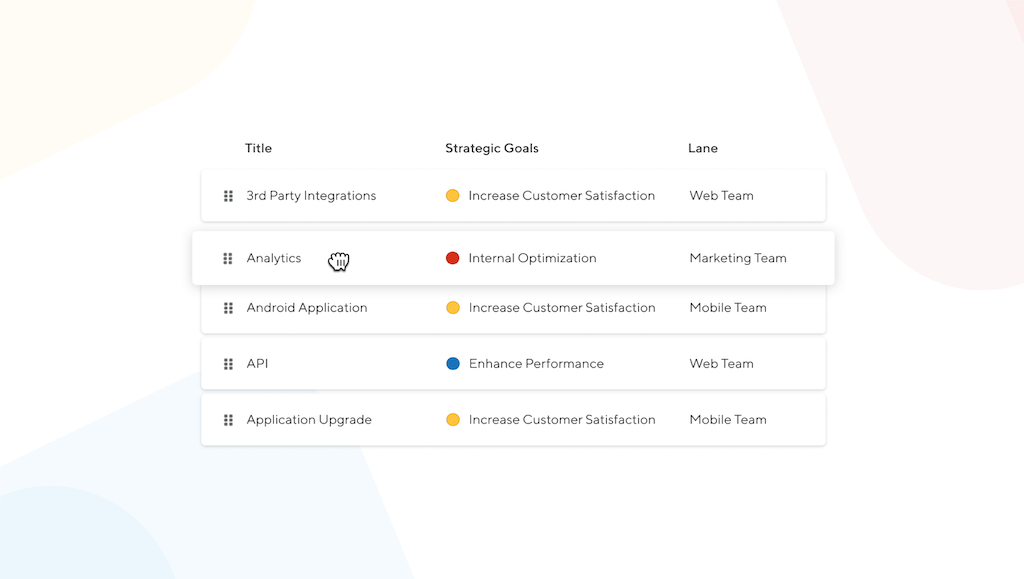At ProductPlan, we have the tremendous privilege of working with and listening to tens of thousands of product leaders. Our customers span across thousands of organizations ranging from smaller, growth-stage startups to Fortune 500 global enterprises. This vantage point has helped us better understand what communication strategies work best. Moreover, we understand why companies face alignment issues, and why products fail to live up to expectations.
In particular, we’ve observed customers struggling to democratize access to the artifacts & insights that inform prioritization and go-to-market. The roadmap can serve as an organizational blueprint that binds strategy and execution. To assure product success, product organizations need to ensure the entirety of the organization is informed, aligned, and accountable.
Whether that means automating time-consuming approval processes, creating a central repository for go-to-market artifacts, or providing more meaningful analytics on product progress, ProductPlan’s product operations platform will help organizations orchestrate their entire product strategy.
Change is Afoot
Many of our customers are in the midst of rapid change. For some customers, this change may be rebalancing how collaboration happens with an increasingly remote workforce. Others are witnessing larger-scale changes to their business model as buying behaviors shift in response to current macroeconomic or other factors.
Product-led growth (PLG) companies are becoming increasingly commonplace as PLG unlocks distribution advantages that can lower acquisition costs and improve the consumer purchasing experience in b2c and b2b businesses. Gartner reported that 85% of organizations surveyed had adopted or intended to adopt a product-centric delivery model.
The proliferation of software tooling to support data analytics, user research, and design, among other areas, has never been more accessible for product teams. While these tools often solve acute problems for their purpose, data managed within these tools can remain siloed, adding further complexity to the product organization. This ‘swivel chair process problem’ keeps product organizations from elevating critical strategic perspectives to the broader organization. ProductPlan helps stitch together this siloed data to create a more unified view of the product story.
Tool proliferation is one of the reasons companies are introducing Product Operations into their organizations. The emergence of Revenue and Sales Operations disciplines and platforms such as Salesforce.com, which enabled organizations to improve transparency, alignment, and operational rigor, serve as a potential analog for what lies in store for Product. We view ourselves as a close product partner to this emerging discipline.
Embracing digital transformation
Finally, incumbents within industries such as financial services and healthcare that tend to embrace change more slowly are in the midst of a significant digital transformation as the competitive landscape shifts around them. Our SVP of Engineering, Mark Barbir, recently wrote about Implementing a Successful Product Transformation Strategy addressing digital transformation among other topics in case you are interested in learning more.
Elevating The Product Organization
All of these changes have accelerated the demand for product managers. Our 2021 State of Product Management Annual Report noted that interest in product management has doubled in the last five years. We also see an increase in product operations evidenced by LinkedIn’s recent assertion that the job skill of product operations has increased by 80% within the past year.
Despite these changes, many product teams still use slide decks or spreadsheets to communicate their roadmap strategy. They’re sharing information without context that no one can ‘double-click’ into to learn more. As a result, product managers spend too much time answering low-value questions from stakeholders. 60% of product managers say they spend most of their time updating teams internally, according to our 2021 State of Product Management Annual Report.
Yet strong alignment among Product, engineering, and the entirety of the go-to-market function is pivotal in delivering positive outcomes. Marketing needs to understand more about the persona or segment targeted. Sales want customer stories and the latest slide deck. Executives want to understand the KPIs and other metrics that will determine success. The product organization has the potential to be the heart of this insight connecting the broader team more closely to the product strategy to unlock crisper execution.
We believe the companies that can successfully elevate the product organization to the heart of strategy & execution will be the most equipped to disrupt the future. The change will require executives across the organization to think differently about the role of Product within the company. Many product leaders may feel powerless to initiate systemic changes. However, we are here to partner in this revolution.



